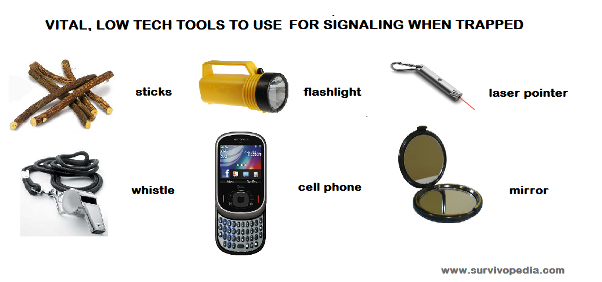In a time of crisis there will be people trapped or buried alive in buildings.
Others may be trapped in elevators or other types of lifts. Still others may wind up trapped underground in subways, tunnels, and parking garages. Here are a few things that might save your life.
How to Signal During a Crisis
There are some vital, low tech tools you should always have on your person or around you for signaling: stick to rap on pipes with, whistle, flashlight, mirror, laser pointer, cell phone, and personal alert system.
No matter whether you are trapped, or are trying to help find others survivors, knowing how to use these signals and detect them is very important:
- Yelling is good for short distances. Be careful not to yell too loud in an unstable area or you could literally bring down the roof.
- Tapping on pipes: The sound produced can travel a good distance. You can try to use Morse Code (a system of dots and dashes) to send messages. Even though most modern rescue teams are not taught how to read or send messages in Morse Code, the more preppers keep up with it, the better chance you’ll have of sending messages to fellow preppers. If you only choose one simple code to learn; make it SOS, which is still the international call for help: …- – -… (where … means S, – – – means O, and … means S, too).
- Blowing a whistle. They can be heard at a distance and can also be used to send Morse Code.
- Use a flashlight in low light conditions to flash a signal to others. Can be used to send SOS or just flash to get attention.
- A mirror or other shiny material can also be used to flash a signal to others. In daylight the flashing of a mirror or other shiny material can be seen for miles.
- Laser pointers: At night a laser pointer is good to signal search and rescue aircraft. The air crew will be wearing night vision which can see the laser beam at a good distance and follow the beam back to its origin.
- In areas that still have electricity, flickering the overhead lights can get attention, and can be seen for miles at night. This action usually will bring aircraft or other search groups to investigate.
- Cell phones: In a time of crisis cell phones may not be working due to damaged or destroyed cell towers, they may jammed by high call volume, or you are out of range of a tower. Never give up trying, you may get through and give your location and status to the other person.
- Personal alert beacons (ex. medical alert bracelets): Activate the unit. The signal may reach a signal tower.
- Portable ham radio units: These two way radios are designed to be used in a time of crisis. Depending on what frequency and what type of antenna you are using, you can communicate with people around the world or any search or rescue headquarters in your area.
Basic Things You Should Do No Matter Where You Are Trapped

Following these steps can help you reach safety, and also make it possible to detect other survivors and help them escape with you.
If possible, always try to keep a small medical kit with you and a few hand tools. The medical kit can be as simple as a few pain killers, gauze for wrapping up wounds, rubbing alcohol, and small bits of wood for splints. A Swiss Army Knife will give you access to just about anything you might need to manage small problems on your own.
If you did not make it outside of the building as it was falling down, you are most likely pinned down or in a sheltered spot under the debris. Following these steps will help you gain focus and pay attention to critical aspects of the situation that might otherwise be overlooked:
- Take a moment to get your thoughts together and try not to panic. If you do panic, the odds of you escaping will be low.
- How much breathable air do you have? After the dust and debris have settled down, is there any air flow in your area? If yes, the chances of survival have just risen. If not your race against time has begun.
- Are there any dangerous utility leaks nearby? If there is an odor of natural gas or fuel oil, do not light a match or other flame source to light up your area. The chance of fire or explosion are too great.
- Is there the sound of running water or the smell of sewage? If so, is it starting to pool up or continue to flow toward or away from you? Never touch wet or watery places because you never know if live wires are pumping current into them.
- Are there any hot or sparking electrical wires near you or near any water? Avoid them and anything they may be pumping power into as much as possible. Test areas by throwing small bits of debris to check for live current, and then use a dry wooden board or other electrically insulated material to move the wires out of your way if needed.
- Determine what floor you are on. Depending on the location, you can try to reach the upper portions and wait for rescue by air crews, or try to work your way down to the ground. If lower levels are flooding, you may have to go up, however this tends to be the more dangerous option because of structural instability.
- Are there others survivors? Call out, whistle, or bang on pipes to get attention. If others respond back, try to find out what their status is, are there others with them, and where they are in relation to you.
- Do they need medical attention? Are they hurt, if so how bad?
- Are they pinned down or are they in a sheltered spot? Is their area stable or unstable (are debris still falling or have they stopped falling).
- Is it possible to signal to people outside the building using mirrors, flashlights, or banging pipes? Even if it was a limited area crisis the odds are the cell towers would be down, but you can still try to call.
- Can you get to other survivors safely? Assess the debris field. Can you safely move toward others that are trapped without causing debris to fall and make the area unstable? If you can do it, move very slowly and take your time to test what is left of the flooring, walls, and ceiling areas before putting your full weight on them. If the area is unstable try another route.
- If you cannot get to the other trapped individuals, but you can escape, do so and go for help. Before leaving tell the others what your plans are to keep them from panicking.
Learn more about survival skills in Conquering the Coming Collapse.
Special Considerations for Multistory or High Rise Buildings
After a devastating event is over there will be people trapped in what is left of the bent, broken, or twisted remains of multistory or high rise buildings. If you are one of the survivors that were not pinned down or crushed, consider yourself very lucky.
In the event of a major crisis, the odds are you will be on your own. A plan of how to descend down to ground level is very important. If you routinely work or visit a multi-story building, start from now to find out where all staircases and emergency entrances are.
Even though the landscape will change drastically during a crisis, having some idea of where certain things were can be of some help.
Overall, elevators will be too dangerous and out of the consideration to use in a crisis. The safest way down from a tall building is by using the stairway.
If the stairs are blocked below your location, scout out the last floor where you might be able to find access to another downward set of stairs. Keep doing this until you reach ground level or run into a search party that can get all of you to safety. Once out, try to give search and rescue headquarters the locations of people that were trapped in your building.
What to Do if You Are Trapped in an Elevator
If you are trapped in an elevator during a crisis try not to panic. Take the time to assess your situation and use the following to try and escape:
- Try calling on the elevator emergency phone for help: If the phone is answered inform them of how many people are trapped and on what floor you are near for the rescue team. If there is no answer, start to think of a way to escape.
- Wait for a few minutes to see if emergency power cuts in. If the power starts, the elevator will return to the lobby. If it does not come on you must think of a way to get out and work your way down to the lobby.
- Yelling or banging on the side of the elevator is a good way to get attention. Use a cell phone to alert others that you are trapped in an elevator. If that doesn’t work; you will need to find a way to get out of the elevator.
- If no chance of outside help seems possible, release the inner elevator door to see exactly where you are in the elevator shaft. If the elevator is too low to reach the outer door release, open the top service hatch to check the distance and location of the outer door.
- Use the service ladder on the wall, ascend up to the outer door, and open it manually. If the door cannot be opened then you must descend to the next lower floor by ladder and see if you can manually release that outer door.
- If the door opens scout out the area to see if there is access to a workable stairway. Finally return to the elevator and help remove other trapped individuals to the safety of the floor below. From this floor take the stairs to the ground floor.
What if You Are Trapped in Subways, Tunnels, or Underground Parking Garages?
When a major crisis hits there is a strong probability that city dwellers will be trapped underground in subways, tunnels, or parking garages. Being trapped underground can easily panic an individual because these areas tend to be dark or poorly lit.
If this happens to you, start by using the basic steps to use regardless of where you are trapped, and then do the following:
- Make sure you know if there are dangers from underground utilities (water, sewage, and natural gas or power lines)? If trapped in a subway the power or third rail may still be charged and carries high voltage that can kill. Breaks in water or sewage pipes present drowning risks, broken underground power conduits with exposed wiring have electrical shock dangers, and broken gas lines can cause fires and explosions.
- Can street sounds be heard from your location or is it just silence? Parking garages have the levels marked or numbered, tunnels have location locators, and subways have track levels.
- How bad is the cave in? Do not start digging unless you are sure the area is stable enough and that you will not cause a collapse on areas where other people may be trapped.
- Are there any emergency stairs that are not blocked? In all underground subways, tunnels, and parking garages there are emergency stairs that lead back to ground level. If the stairs are still intact rescue teams can come down to rescue and treat survivors.
In a time of crisis, you may be trapped in buildings and elevators above ground or in underground subways, tunnels, or parking garages. When debris start to settle and you are a live the last thing you want to do is panic. Panic can run through a group and destroy it.
Sit down and try to relax, think and do not give up. Work hard as a team and your chances of surviving are good.










Christopher de Vidal | May 20, 2014
|
When cell phone towers are too busy, sometimes text messages will get through instead. Additionally, a text message will keep trying to send if your signal is intermittant. And a phone on a long stick can be raised for sending texts with a better signal.
Pingback:Bug-Out Backup: How to Find Emergency Shelter Underground | May 22, 2014
|
Pingback:Say Goodbye to Paper Good: Josh’s Take on Survival Knowledge | TheSurvivalPlaceBlog | May 27, 2014
|
Benjamin Perez | May 11, 2015
|
Saved like a favourite, wonderful website!
Patrick | June 3, 2015
|
For some corrections:
1. On paragraph two (2), “sticks to “tap” on pipes with”
2. SOS morse code would be three (3) dots, two (2) dashes, and three (3) dots again (…–…)
Very informative and helpful.
Thank you.
Scott Todd | December 13, 2015
|
Two dashes is the letter M; three is O.
Morse | September 11, 2015
|
One cannot send morse code simply tapping on an object. There has to be a way to distinguish between a short pulse (dot) and a long pulse (dash) for morse code to work. That is impossible by simply tapping, since if someone taps twice, it could be an a, i, or an n… it’s impossible to know which. Add that to all the other letters that share the same number of elements in it’s form in morse code, and even a skilled morse operator would be unable to communicate with just taps. Instead, learn how to actually use a “tap code”. Personally I think some sort of tap code should be taught to all children at an age they can read and write. One of the most popular tap codes is known as a “5×5” tap code.
Bob | March 29, 2020
|
The space between the taps will serve to define the dot or dash. Three quick taps will define S and three slow taps will define O.
Pingback:Preparing For Nuclear Disaster: How To Stay Informeddisasterdefense.us | disasterdefense.us | November 19, 2015
|
Pingback:How To Speak Survival Abroad: SOS Signs And Languages | Survivopedia | January 23, 2017
|
Pingback:How To Survive And Escape From A Collapsed Building | Survivopedia | January 8, 2018
|